MaxEnt Modeling for Predicting the Current and Future Potential Geographical Distribution of Quercus libani Olivier
Abstract
1. Introduction
2. Materials and Methods
3. Results
3.1. Statistical Analysis of Bioclimatic Variables
3.2. Current and Future Potential Geographical Distribution of Quercus Libani Olivier and Its Suitability According to Global Climate Change Scenarios
3.3. Changes from the Current Potential Geographical Distribution of Quercus libani Olivier
4. Discussion
5. Conclusions
Author Contributions
Funding
Conflicts of Interest
References
- Adhikari, D.; Barik, S.; Upadhaya, K. Habitat distribution modelling for reintroduction of Ilex khasiana Purk., a critically endangered tree species of northeastern India. Ecol. Eng. 2012, 40, 37–43. [Google Scholar] [CrossRef]
- Barnosky, A.D.; Matzke, N.; Tomiya, S.; Wogan, G.O.; Swartz, B.; Quental, T.B.; Marshall, C.; McGuire, J.L.; Lindsey, E.L.; Maguire, K.C. Has the Earth’s sixth mass extinction already arrived? Nature 2011, 471, 51–57. [Google Scholar] [CrossRef] [PubMed]
- Lenoir, J.; Gégout, J.-C.; Marquet, P.; De Ruffray, P.; Brisse, H.J.S. A significant upward shift in plant species optimum elevation during the 20th century. Science 2008, 320, 1768–1771. [Google Scholar] [CrossRef] [PubMed]
- Bertrand, R.; Lenoir, J.; Piedallu, C.; Riofrío-Dillon, G.; de Ruffray, P.; Vidal, C.; Pierrat, J.-C.; Gégout, J.-C.J.N. Changes in plant community composition lag behind climate warming in lowland forests. Nature 2011, 479, 517–520. [Google Scholar] [CrossRef] [PubMed]
- Türkeş, M. Küresel iklim değişikliği nedir? Temel kavramlar, nedenleri, gözlenen ve öngörülen değişiklikler. İklim Değişikliği ve Çevre 2008, 1, 26–37. [Google Scholar]
- Worth, J.R.; Harrison, P.A.; Williamson, G.J.; Jordan, G.J. Whole range and regional-based ecological niche models predict differing exposure to 21st century climate change in the key cool temperate rainforest tree southern beech (N othofagus cunninghamii). Austral Ecol. 2015, 40, 126–138. [Google Scholar] [CrossRef]
- Liu, X.; Pan, Y.; Zhu, X.; Li, S. Spatiotemporal variation of vegetation coverage in Qinling-Daba Mountains in relation to environmental factors. Acta Geogr. Sin 2015, 5, 705–716. [Google Scholar]
- Wang, B.; Xu, G.; Li, P.; Li, Z.; Zhang, Y.; Cheng, Y.; Jia, L.; Zhang, J. Vegetation dynamics and their relationships with climatic factors in the Qinling Mountains of China. Ecol. Indic. 2020, 108, 105719. [Google Scholar] [CrossRef]
- IPCC. Climate Change 2014: Synthesis Report. Contribution of Working Groups I, II and III to the Fifth Assessment Report of the Intergovernmental Panel on Climate Change; IPCC: Geneva, Switzerland, 2014; p. 151. [Google Scholar]
- Chichorro, F.; Juslén, A.; Cardoso, P. A review of the relation between species traits and extinction risk. Biol. Conserv. 2019, 237, 220–229. [Google Scholar] [CrossRef]
- Ashraf, U.; Ali, H.; Chaudry, M.N.; Ashraf, I.; Batool, A.; Saqib, Z. Predicting the potential distribution of olea ferruginea in pakistan incorporating climate change by using maxent model. Sustainability 2016, 8, 722. [Google Scholar] [CrossRef]
- Cobben, M.M.P.; van Treuren, R.; Castaneda-Alvarez, N.P.; Khoury, C.K.; Kik, C.; van Hintum, T.J.L. Robustness and accuracy of Maxent niche modelling for Lactuca species distributions in light of collecting expeditions. Plant Genet. Resour.-C 2015, 13, 153–161. [Google Scholar] [CrossRef]
- Fitzpatrick, M.C.; Gove, A.D.; Sanders, N.J.; Dunn, R.R. Climate change, plant migration, and range collapse in a global biodiversity hotspot: The Banksia (Proteaceae) of Western Australia. Glob. Chang. Biol. 2008, 14, 1337–1352. [Google Scholar] [CrossRef]
- Lawler, J.J.; Shafer, S.L.; White, D.; Kareiva, P.; Maurer, E.P.; Blaustein, A.R.; Bartlein, P.J. Projected climate-induced faunal change in the Western Hemisphere. Ecology 2009, 90, 588–597. [Google Scholar] [PubMed]
- Thuiller, W.; Lavorel, S.; Araújo, M.B.; Sykes, M.T.; Prentice, I.C. Climate change threats to plant diversity in Europe. Proc. Natl. Acad. Sci. USA 2005, 102, 8245–8250. [Google Scholar] [PubMed]
- Yi, Y.J.; Cheng, X.; Yang, Z.F.; Zhang, S.H. Maxent modeling for predicting the potential distribution of endangered medicinal plant (H. riparia Lour) in Yunnan, China. Ecol. Eng. 2016, 92, 260–269. [Google Scholar] [CrossRef]
- Zhang, K.; Yao, L.; Meng, J.; Tao, J. Maxent modeling for predicting the potential geographical distribution of two peony species under climate change. Sci. Total Environ. 2018, 634, 1326–1334. [Google Scholar]
- Gaston, K.J. Species richness: Measure and measurement. Biodibersity: A Biology of Numbers and Difference; Blackwell Science: Hoboken, NJ, USA, 1996; pp. 77–113. [Google Scholar]
- Arslan, E.S. İklim değişimi senaryoları ve tür dağılım modeline göre kentsel yol ağaçlarının ekosistem hizmetleri bağlamında değerlendirilmesi: Robinia pseudoacacia L. örneği. Türkiye Ormancılık Dergisi 2019, 20, 142–148. [Google Scholar] [CrossRef]
- Phillips, S.J.; Dudik, M. Modeling of species distributions with Maxent: New extensions and a comprehensive evaluation. Ecography 2008, 31, 161–175. [Google Scholar] [CrossRef]
- Sarikaya, O.; Karaceylan, I.B.; Sen, I. Maximum Entropy Modeling (Maxent) of Current and Future Distributions of Ips Mannsfeldi (Wachtl, 1879) (Curculionidae: Scolytinae) in Turkey. Appl. Ecol. Environ. Res. 2018, 16, 2527–2535. [Google Scholar] [CrossRef]
- Sérgio, C.; Figueira, R.; Draper, D.; Menezes, R.; Sousa, A.J. Modelling bryophyte distribution based on ecological information for extent of occurrence assessment. Biol. Conserv. 2007, 135, 341–351. [Google Scholar] [CrossRef]
- Tittensor, D.P.; Baco, A.R.; Brewin, P.E.; Clark, M.R.; Consalvey, M.; Hall-Spencer, J.; Rowden, A.A.; Schlacher, T.; Stocks, K.I.; Rogers, A.D. Predicting global habitat suitability for stony corals on seamounts. J. Biogeogr. 2009, 36, 1111–1128. [Google Scholar] [CrossRef]
- Wang, Y.-S.; Xie, B.-Y.; Wan, F.-H.; Xiao, Q.-M.; Dai, L.-Y. The potential geographic distribution of Radopholus similis in China. Agric. Sci. China 2007, 6, 1444–1449. [Google Scholar] [CrossRef]
- Ward, D.F. Modelling the potential geographic distribution of invasive ant species in New Zealand. Biol. Invasions 2007, 9, 723–735. [Google Scholar] [CrossRef]
- Williams, J.N.; Seo, C.; Thorne, J.; Nelson, J.K.; Erwin, S.; O’Brien, J.M.; Schwartz, M.W. Using species distribution models to predict new occurrences for rare plants. Divers. Distrib. 2009, 15, 565–576. [Google Scholar] [CrossRef]
- Wollan, A.K.; Bakkestuen, V.; Kauserud, H.; Gulden, G.; Halvorsen, R. Modelling and predicting fungal distribution patterns using herbarium data. J. Biogeogr. 2008, 35, 2298–2310. [Google Scholar] [CrossRef]
- Yuan, H.S.; Wei, Y.L.; Wang, X.G. Maxent modeling for predicting the potential distribution of Sanghuang, an important group of medicinal fungi in China. Fungal Ecol. 2015, 17, 140–145. [Google Scholar] [CrossRef]
- Brito, J.C.; Acosta, A.L.; Álvares, F.; Cuzin, F. Biogeography and conservation of taxa from remote regions: An application of ecological-niche based models and GIS to North-African Canids. Biol. Conserv. 2009, 142, 3020–3029. [Google Scholar] [CrossRef]
- Elith, J.; Leathwick, J.R. Species distribution models: Ecological explanation and prediction across space and time. Annu. Rev. Ecol. Evol. Syst. 2009, 40, 677–697. [Google Scholar] [CrossRef]
- Wei, B.; Wang, R.L.; Hou, K.; Wang, X.Y.; Wu, W. Predicting the current and future cultivation regions of Carthamus tinctorius L. using MaxEnt model under climate change in China. Glob. Ecol. Conserv. 2018, 16. [Google Scholar] [CrossRef]
- Pearson, R.G.; Raxworthy, C.J.; Nakamura, M.; Townsend Peterson, A. Predicting species distributions from small numbers of occurrence records: A test case using cryptic geckos in Madagascar. J. Biogeogr. 2007, 34, 102–117. [Google Scholar] [CrossRef]
- Tsoar, A.; Allouche, O.; Steinitz, O.; Rotem, D.; Kadmon, R. A comparative evaluation of presence-only methods for modelling species distribution. Divers. Distrib. 2007, 13, 397–405. [Google Scholar] [CrossRef]
- Lv, X.; Zhou, G. Climatic suitability of the geographic distribution of Stipa breviflora in Chinese temperate grassland under climate change. Sustainability 2018, 10, 3767. [Google Scholar] [CrossRef]
- Wu, W.; Li, Y.; Hu, Y.; Xiu, C.; Yan, X. Impacts of changing forest management areas on forest landscapes and habitat patterns in northeastern China. Sustainability 2018, 10, 1211. [Google Scholar] [CrossRef]
- Dündar, T. Demirköy yöresi Istranca meşelerinin (Quercus hartwissiana Stev.) fiziksel özellikleri. İstanbul Üniversitesi Orman Fakültesi Dergisi 2001, 51, 65–80. [Google Scholar]
- GDF. Turkish Forestry Statistics. Available online: https://www.ogm.gov.tr/ekutuphane/Istatistikler/Forms/AllItems.aspx (accessed on 10 January 2020).
- Yaltırık, F. Manual for Identification of Turkish Oaks; General Directorate of Forestry Press: Eskişehir, Turkey, 1984. [Google Scholar]
- IUCN. The IUCN Red List of Threatened Species. Available online: https://www.iucnredlist.org/en (accessed on 11 January 2020).
- Stephan, J. The IUCN Red List of Threatened Species 2018. E.T194187A2303417, 11 September 2018. [Google Scholar]
- Grieve, M. A Modern Herbal; Courier Corporation: Chelmsford, MA, USA, 2013; Volume 2. [Google Scholar]
- Abrahami, A. Quercus Libani Jpg. Available online: https://upload.wikimedia.org/wikipedia/commons/0/07/Quercus_libani_port.jpg (accessed on 14 February 2020).
- Akkemik, Ü. Türkiye’nin doğal-egzotik ağaç ve çalıları I; Orman Genel Müdürlüğü Yayınları: Ankara, Turkey, 2014. [Google Scholar]
- Davis, P.H. Flora of Turkey and the East Aegean Islands—VIII; David, P.H., Ed.; Edinburgh University Press: Edinburgh, UK, 1984; Volume 8. [Google Scholar]
- GBIF. Global Biodiversity Information Facility. Available online: https://www.gbif.org/species/5293186 (accessed on 10 December 2019).
- Yaltırık, F. Türkiye Meşeleri Teşhis Kılavuzu; Tarım Orman ve Köyişleri Bakanlığı Genel Müdürlüğü Yayını: İstanbul, Turkey, 1984. [Google Scholar]
- QGis. QGis 3.8 Zanzibar—A Free and Open GIS. Available online: https://qgis.org/tr/site/forusers/download.html (accessed on 20 August 2019).
- WorldClim. WorldClim—Global Climate Data. Available online: www.worldclim.org (accessed on 20 August 2019).
- Hijmans, R.J.; Cameron, S.E.; Parra, J.L.; Jones, P.G.; Jarvis, A. Very high resolution interpolated climate surfaces for global land areas. Int. J. Climatol. J. R. Meteorol. Soc. 2005, 25, 1965–1978. [Google Scholar] [CrossRef]
- Moss, R.H.; Edmonds, J.A.; Hibbard, K.A.; Manning, M.R.; Rose, S.K.; Van Vuuren, D.P.; Carter, T.R.; Emori, S.; Kainuma, M.; Kram, T. The next generation of scenarios for climate change research and assessment. Nature 2010, 463, 747–756. [Google Scholar] [CrossRef]
- Remya, K.; Ramachandran, A.; Jayakumar, S. Predicting the current and future suitable habitat distribution of Myristica dactyloides Gaertn. Using MaxEnt model in the Eastern Ghats, India. Ecol. Eng. 2015, 82, 184–188. [Google Scholar] [CrossRef]
- Hunt, L.P.; Petty, S.; Cowley, R.; Fisher, A.; Ash, A.J.; MacDonald, N. Factors affecting the management of cattle grazing distribution in northern Australia: Preliminary observations on the effect of paddock size and water points1. Rangel. J. 2007, 29, 169–179. [Google Scholar] [CrossRef]
- CESM. Community Earth System Model (CESM)/CCSM4.0 Public Release. Available online: http://www.cesm.ucar.edu/models/ccsm4.0/ (accessed on 10 December 2019).
- Field, A. Discovering Statistics Using IBM SPSS Statistics; Sage: Thousand Oaks, CA, USA, 2013. [Google Scholar]
- Yurdugül, H. Faktör analizinde KMO ve Bartlett testleri neyi ölçer. Available online: http://yunus.hacettepe.edu.tr/~yurdugul/3/indir/Kuresellik.pdf (accessed on 10 January 2020).
- IBM. FACTOR does not print KMO or Bartlett test for Nonpositive Definite Matrices. Available online: https://www.ibm.com/support/pages/factor-does-not-print-kmo-or-bartlett-test-nonpositive-definite-matrices (accessed on 5 January 2020).
- Aït-Sahalia, Y.; Xiu, D. Principal component analysis of high-frequency data. J. Am. Stat. Assoc. 2019, 114, 287–303. [Google Scholar] [CrossRef]
- Phillips, S.J.; Anderson, R.P.; Schapire, R.E. Maximum entropy modeling of species geographic distributions. Ecol. Model. 2006, 190, 231–259. [Google Scholar] [CrossRef]
- Phillips, S.J. A brief tutorial on Maxent. AT T Res. 2005, 190, 231–259. [Google Scholar]
- Phillips, S.J.; Elith, J. POC plots: Calibrating species distribution models with presence-only data. Ecology 2010, 91, 2476–2484. [Google Scholar] [CrossRef] [PubMed]
- Zhao, D.; He, H.S.; Wang, W.J.; Wang, L.; Du, H.; Liu, K.; Zong, S. Predicting wetland distribution changes under climate change and human activities in a mid- and high-latitude region. Sustainability 2018, 10, 863. [Google Scholar] [CrossRef]
- Gassó, N.; Thuiller, W.; Pino, J.; Vilà, M. Potential distribution range of invasive plant species in Spain. NeoBiota 2012, 12, 25. [Google Scholar]
- Hosmer Jr, D.W.; Lemeshow, S.; Sturdivant, R.X. Applied Logistic Regression; John Wiley & Sons: Hoboken, NJ, USA, 2013; Volume 398. [Google Scholar]
- Shcheglovitova, M.; Anderson, R.P. Estimating optimal complexity for ecological niche models: A jackknife approach for species with small sample sizes. Ecol. Model. 2013, 269, 9–17. [Google Scholar] [CrossRef]
- Coban, H.O.; Koc, A.; Eker, M. Investigation on changes in complex vegetation coverage using multi-temporal landsat data of Western Black sea region—A case study. J. Environ. Biol. 2010, 31, 169–178. [Google Scholar]
- Yackulic, C.B.; Chandler, R.; Zipkin, E.F.; Royle, J.A.; Nichols, J.D.; Grant, E.H.C.; Veran, S. Presence-only modelling using MAXENT: When can we trust the inferences? Methods Ecol. Evol. 2013, 4, 236–243. [Google Scholar] [CrossRef]
- Thibaud, E.; Petitpierre, B.; Broennimann, O.; Davison, A.C.; Guisan, A. Measuring the relative effect of factors affecting species distribution model predictions. Methods Ecol. Evol. 2014, 5, 947–955. [Google Scholar] [CrossRef]
- Li, Y.; Li, M.; Li, C.; Liu, Z. Optimized maxent model predictions of climate change impacts on the suitable distribution of cunninghamia lanceolata in China. Forests 2020, 11, 302. [Google Scholar] [CrossRef]
- Nameer, P. The expanding distribution of the Indian Peafowl (Pavo cristatus) as an indicator of changing climate in Kerala, southern India: A modelling study using MaxEnt. Ecol. Indic. 2020, 110, 105930. [Google Scholar]
- Gebrewahid, Y.; Abrehe, S.; Meresa, E.; Eyasu, G.; Abay, K.; Gebreab, G.; Kidanemariam, K.; Adissu, G.; Abreha, G.; Darcha, G. Current and future predicting potential areas of Oxytenanthera abyssinica (A. Richard) using MaxEnt model under climate change in Northern Ethiopia. Ecol. Process. 2020, 9, 6. [Google Scholar] [CrossRef]
- Dobrowski, S.Z. A climatic basis for microrefugia: The influence of terrain on climate. Glob. Chang. Biol. 2011, 17, 1022–1035. [Google Scholar] [CrossRef]
- Çoban, H.O.; Çoşgun, S. The role of topography in the spatial distribution of tree species in the Mediterranean region of Turkey. Fresenius Environ. Bull. 2020, 29, 1369–1378. [Google Scholar]
- Luoto, M.; Heikkinen, R. Disregarding topographical heterogeneity biases species turnover assessments based on bioclimatic models. Glob. Chang. Biol. 2008, 14, 483–494. [Google Scholar] [CrossRef]
- Akyol, A.; Örücü, Ö.K. İklim Değişimi Senaryoları ve Tür Dağılım Modeline Göre Kızılcık Türünün (Cornus mas L.) Odun Dışı Orman Ürünleri Kapsamında Değerlendirilmesi. Avrupa Bilim ve Teknoloji Dergisi 2019, 224–233. [Google Scholar] [CrossRef]
- Qin, A.L.; Liu, B.; Guo, Q.S.; Bussmann, R.W.; Ma, F.Q.; Jian, Z.J.; Xu, G.X.; Pei, S.X. Maxent modeling for predicting impacts of climate change on the potential distribution of Thuja sutchuenensis Franch., an extremely endangered conifer from southwestern China. Glob. Ecol. Conserv. 2017, 10, 139–146. [Google Scholar] [CrossRef]
- Al-Qaddi, N.; Vessella, F.; Stephan, J.; Al-Eisawi, D.; Schirone, B. Current and future suitability areas of kermes oak (Quercus coccifera L.) in the Levant under climate change. Reg. Environ. Chang. 2017, 17, 143–156. [Google Scholar] [CrossRef]
- Peterson, A.T.; Papes, M.; Eaton, M. Transferability and model evaluation in ecological niche modeling: A comparison of GARP and Maxent. Ecography 2007, 30, 550–560. [Google Scholar] [CrossRef]
- Raxworthy, C.J.; Pearson, R.G.; Rabibisoa, N.; Rakotondrazafy, A.M.; Ramanamanjato, J.-B.; Raselimanana, A.P.; Wu, S.; Nussbaum, R.A.; Stone, D.A. Extinction vulnerability of tropical montane endemism from warming and upslope displacement: A preliminary appraisal for the highest massif in Madagascar. Glob. Chang. Biol. 2008, 14, 1703–1720. [Google Scholar] [CrossRef]
- Hughes, L. Biological consequences of global warming: Is the signal already apparent? Trends Ecol. Evol. 2000, 15, 56–61. [Google Scholar] [CrossRef]
- İnal, S. Meşe (Quercus) hakkında etimolojik ve tarihi etüdler. İstanbul Üniversitesi Orman Fakültesi Dergisi 1955, 5, 100–111. [Google Scholar]
- OGM. Tohum Meşcereleri. Available online: https://ortohum.ogm.gov.tr/SiteAssets/Sayfalar/Tohum-Mescereleri/Tohum%20Me%C5%9F%C3%A7ereleri(Adeti%20-Toplam%20alan).pdf (accessed on 10 January 2020).
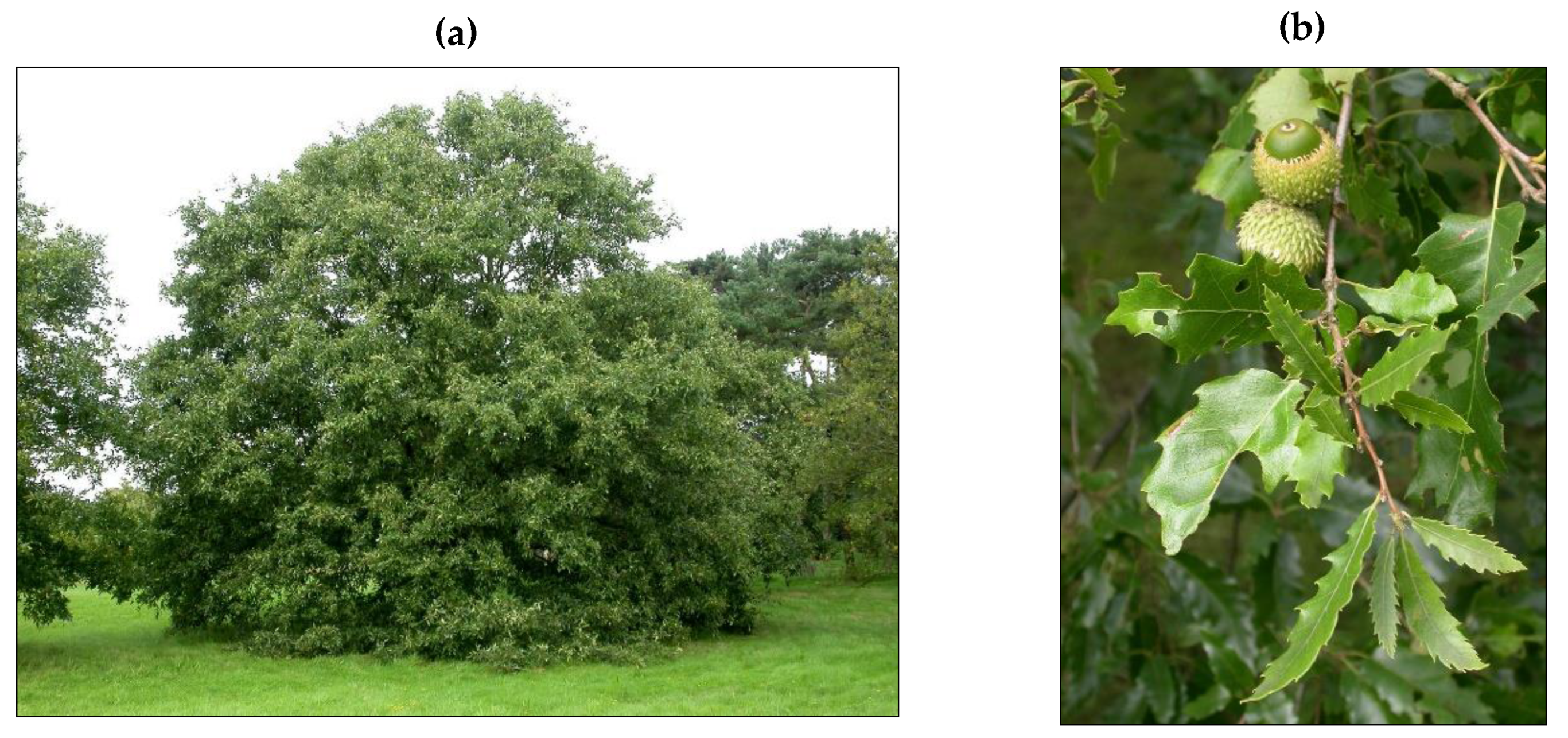
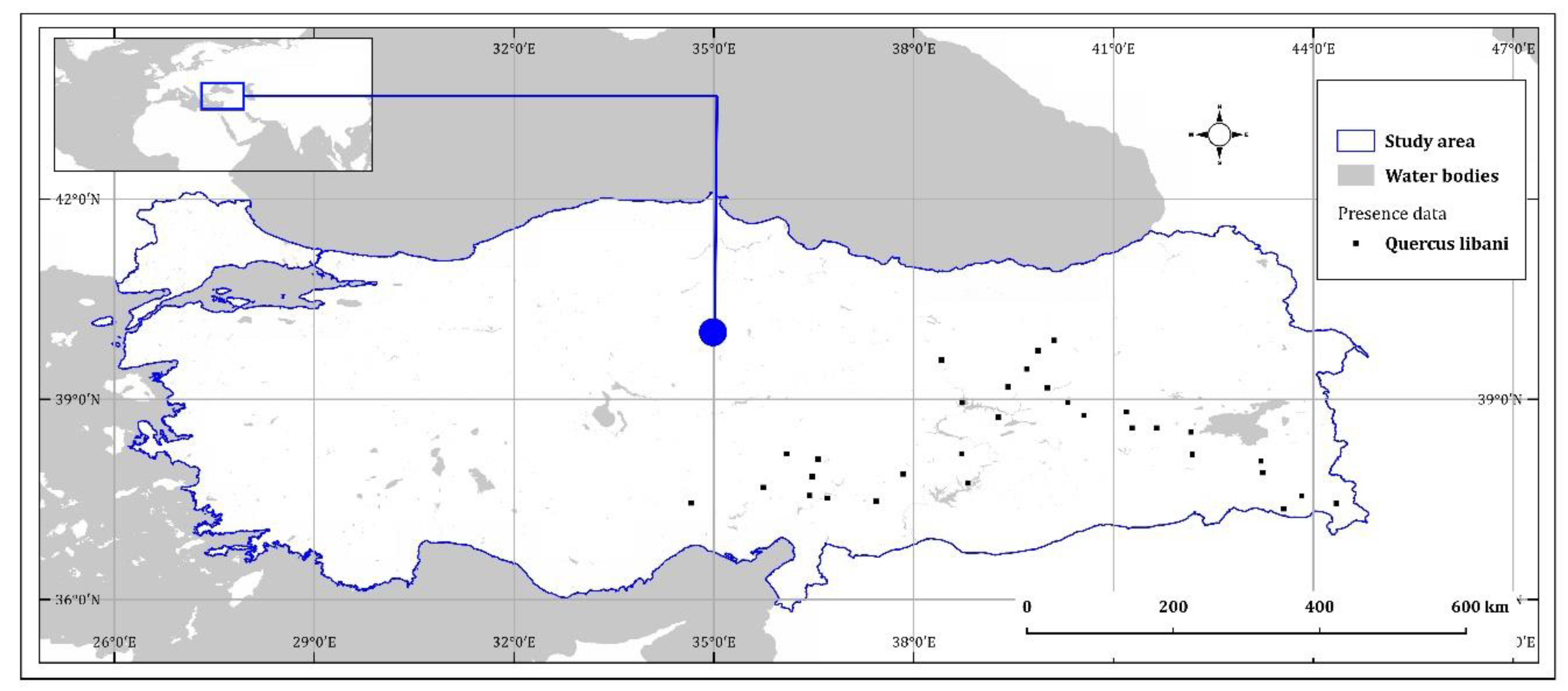
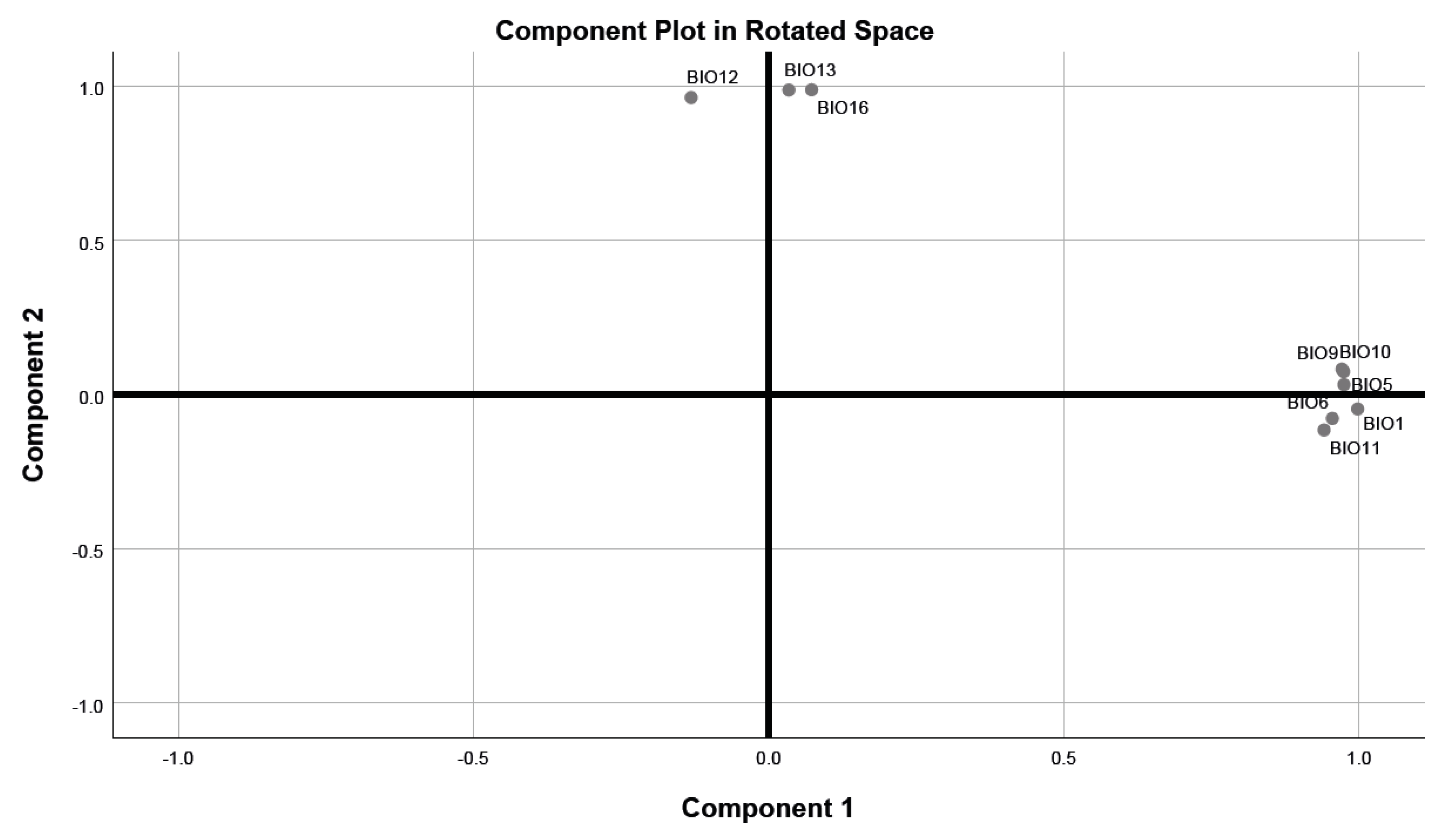
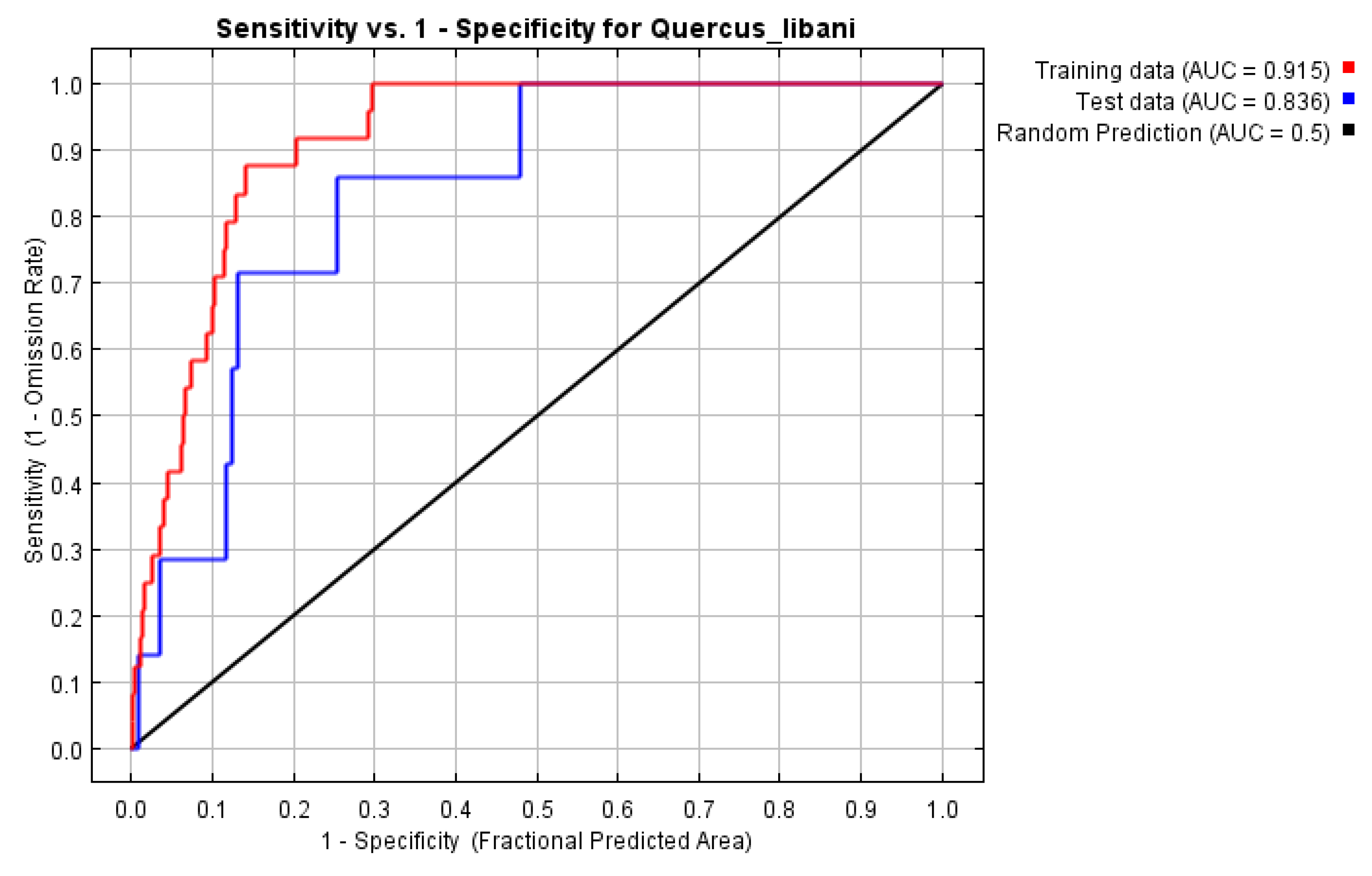
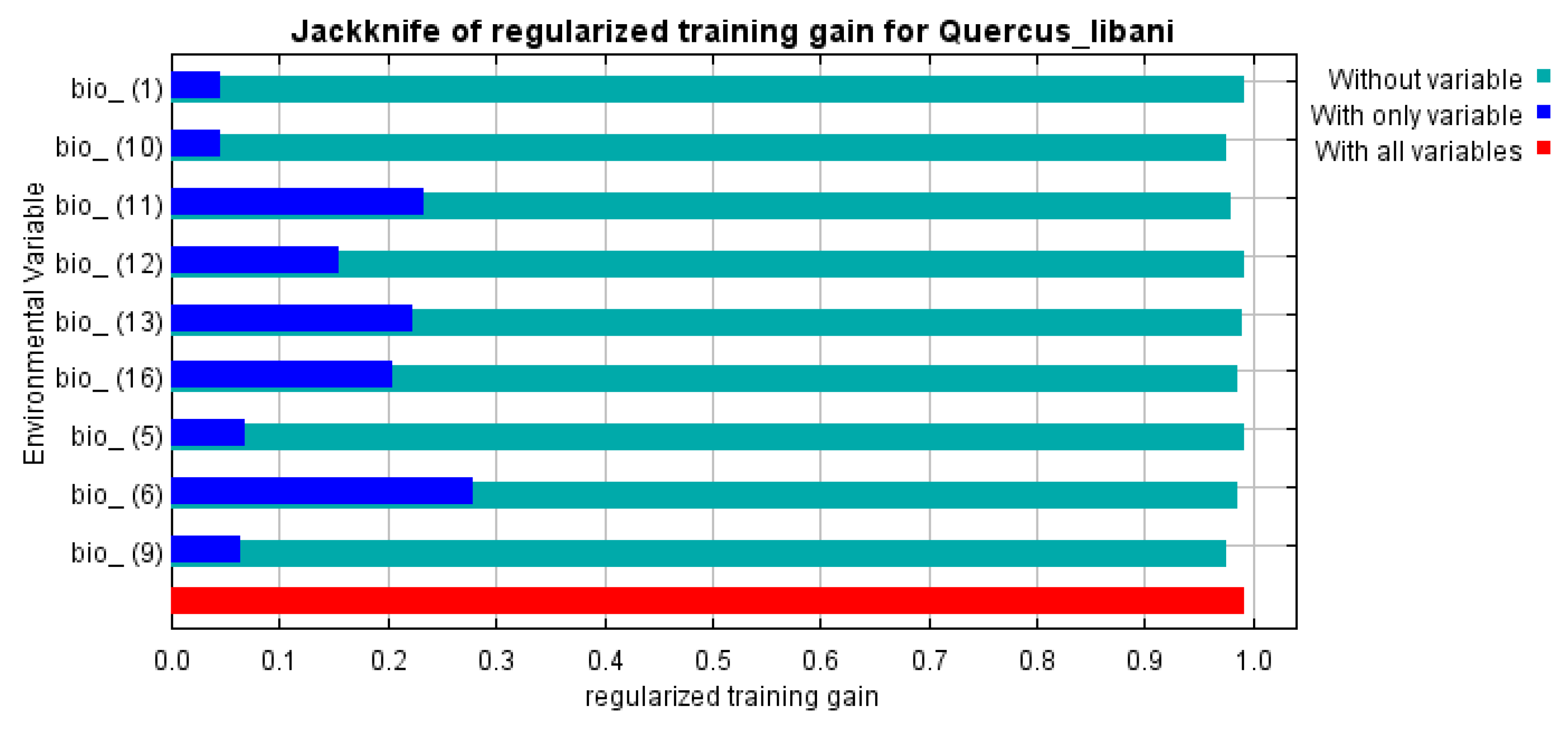
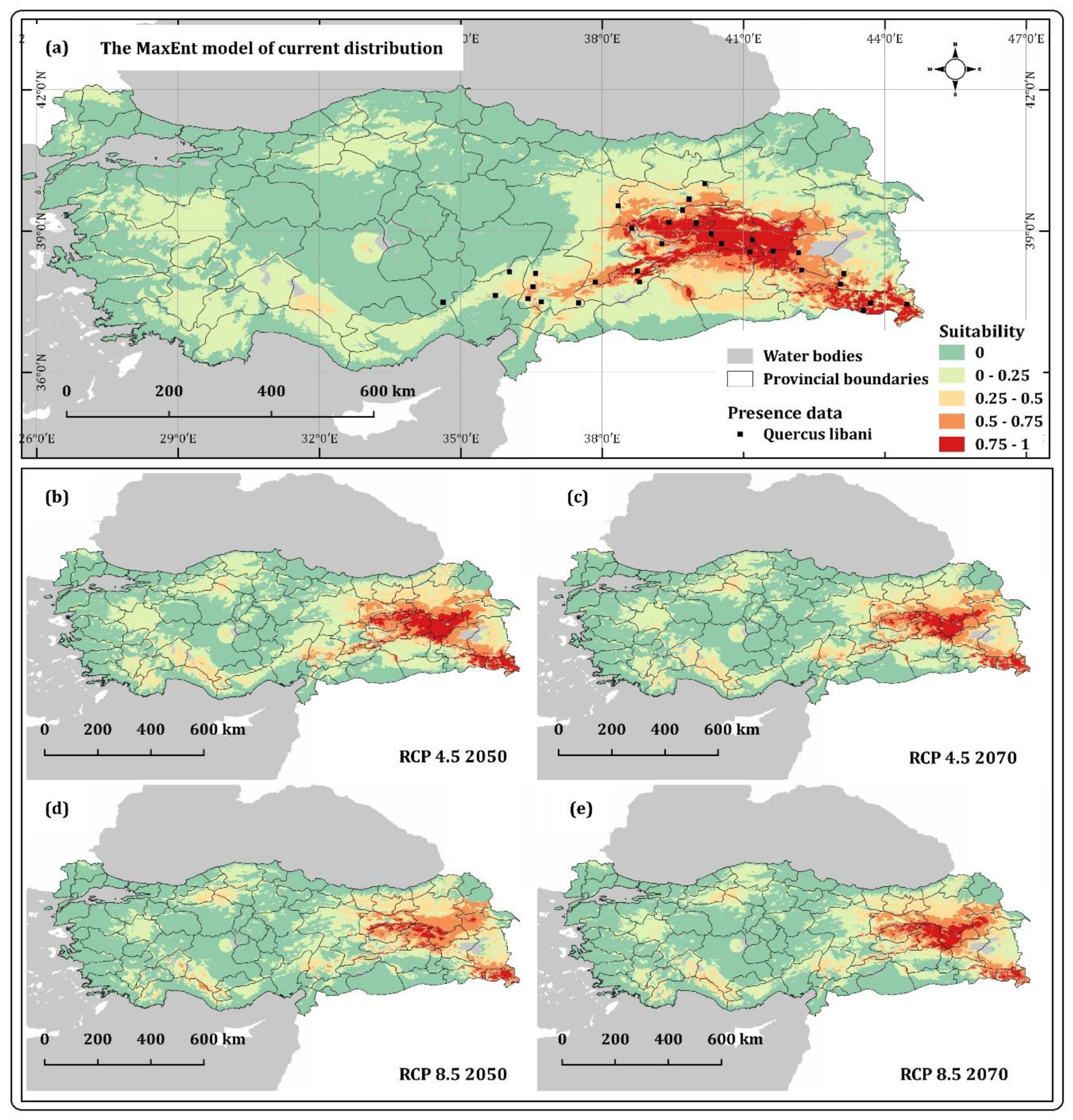
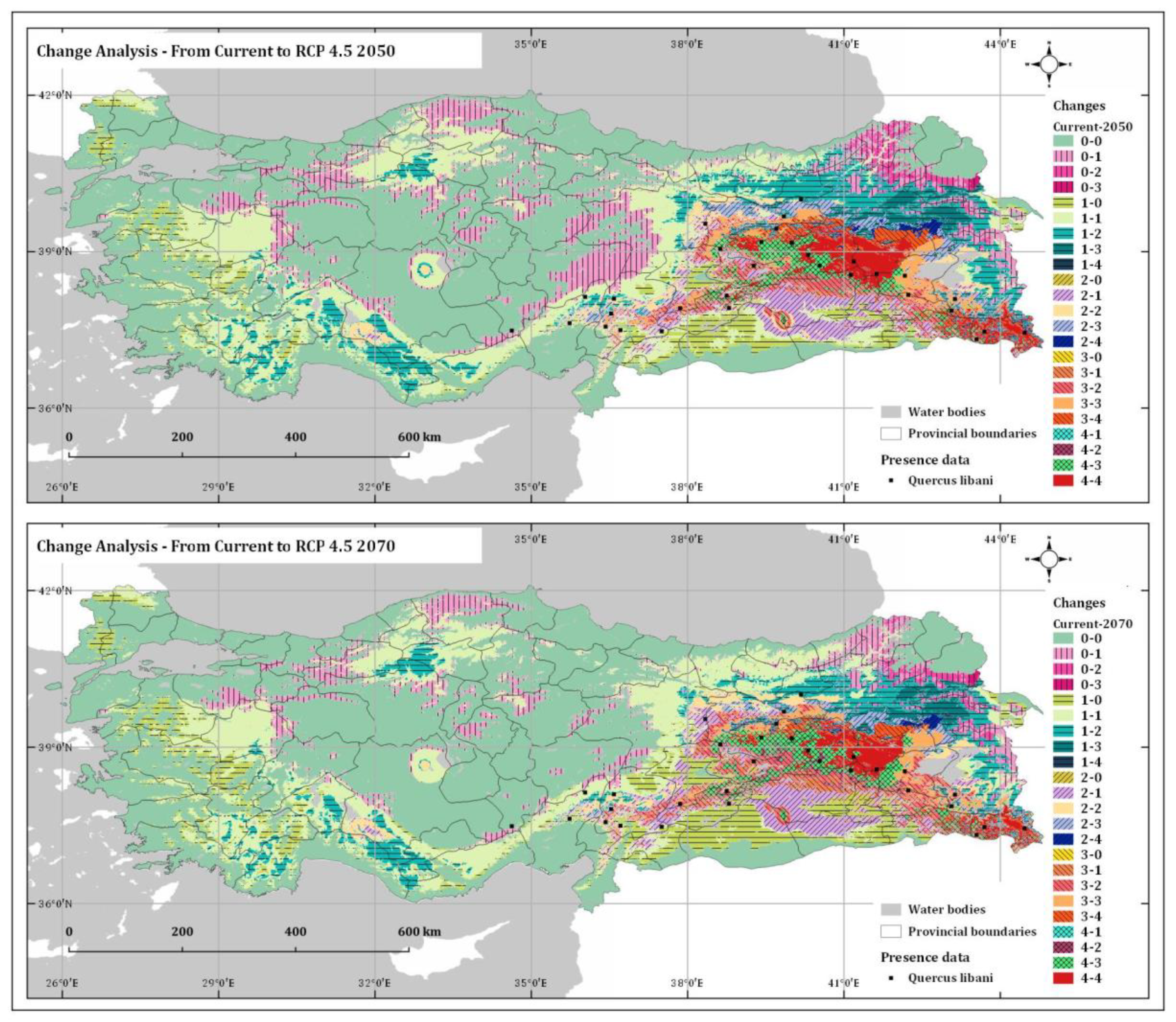
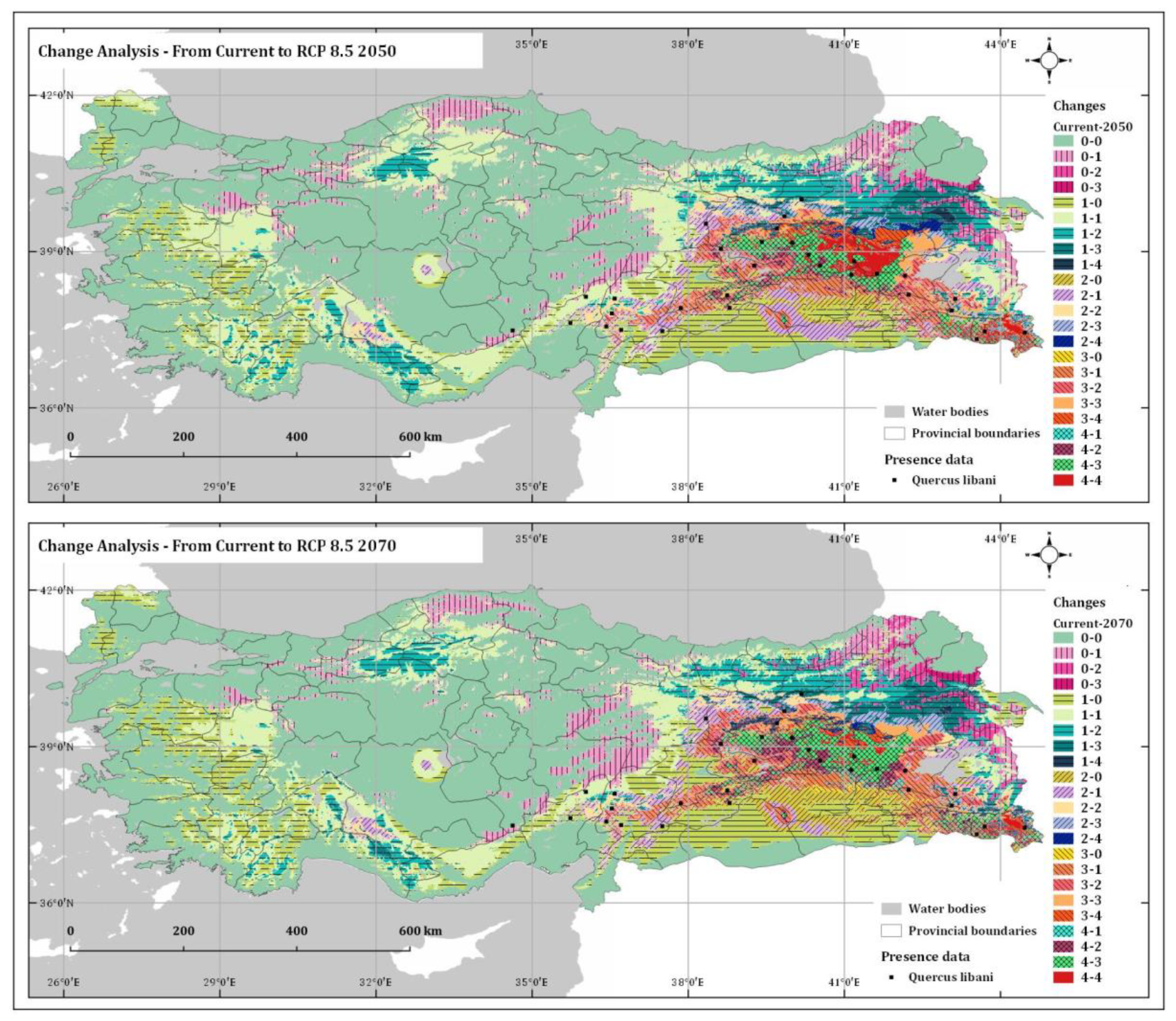
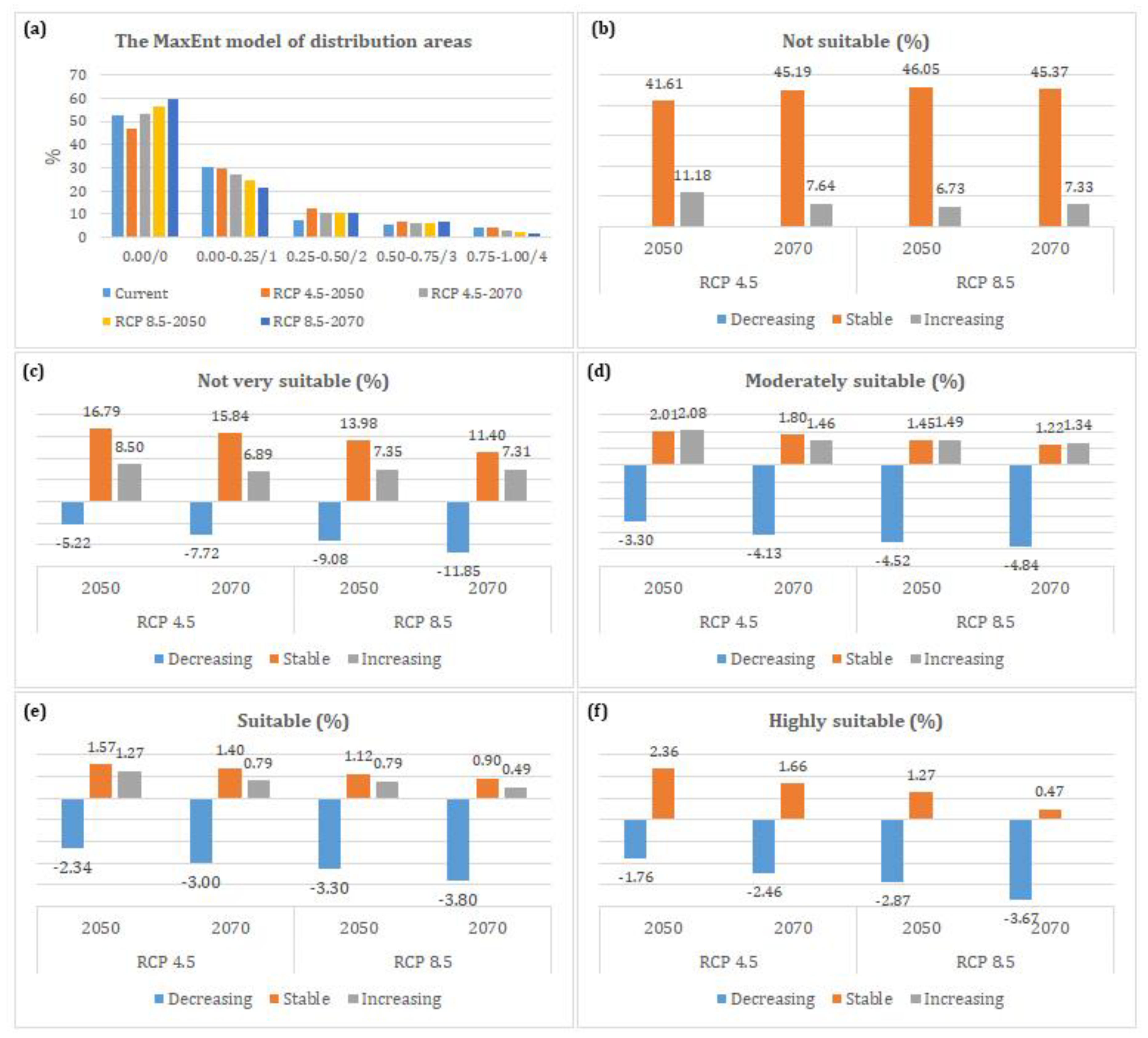
| Point no | Longitude | Latitude | Province | District | Elevation (m) | Aspect (°) | Slope (°) | Precip. (mm) * | Temp. (°C) ** |
|---|---|---|---|---|---|---|---|---|---|
| 1 | 38°47’46” | 37°55’2” | Adiyaman | Gerger | 876 | 25 | 11 | 556 | 13.92 |
| 2 | 37°30’12” | 37°28’24” | K. Maras | Pazarcık | 921 | 164 | 5 | 556 | 14.67 |
| 3 | 38°37’52” | 39°3’23” | Malatya | Arapkir | 988 | 69 | 7 | 623 | 12.93 |
| 4 | 37°51’27” | 37°54’54” | Malatya | Doğanşehir | 995 | 257 | 6 | 532 | 11.16 |
| 5 | 40°32’6” | 38°43’57” | Bingöl | Genç | 1037 | 340 | 7 | 833 | 12.60 |
| 6 | 38°45’5” | 38°9’25” | Malatya | Pötürge | 1083 | 322 | 13 | 554 | 12.58 |
| 7 | 43°32’50” | 37°19’9” | Hakkari | Çukurca | 1229 | 339 | 43 | 808 | 11.21 |
| 8 | 36°25’38” | 37°33’48” | K. Maras | Andırın | 1254 | 350 | 3 | 710 | 11.19 |
| 9 | 39°16’11” | 38°43’51” | Elazığ | Merkez | 1335 | 334 | 13 | 762 | 11.58 |
| 10 | 39°59’55” | 39°10’23” | Tunceli | Nazımiye | 1389 | 100 | 9 | 884 | 10.48 |
| 11 | 41°8’11” | 38°33’19” | Diyarbakir | Kulp | 1414 | 321 | 22 | 919 | 10.14 |
| 12 | 35°44’12” | 37°37’49” | Adana | Kozan | 1461 | 157 | 23 | 650 | 11.72 |
| 13 | 42°14’14” | 38°10’17” | Siirt | Şirvan | 1481 | 164 | 5 | 936 | 8.84 |
| 14 | 41°11’27” | 38°48’51” | Bingöl | Solhan | 1517 | 32 | 6 | 820 | 8.76 |
| 15 | 36°42’44” | 37°29’46” | K. Maras | Merkez | 1532 | 106 | 10 | 655 | 10.50 |
| 16 | 39°25’2” | 39°11’11” | Tunceli | Hozat | 1545 | 232 | 16 | 804 | 8.82 |
| 17 | 43°3’55” | 37°52’13” | Van | Çatak | 1598 | 178 | 27 | 697 | 8.91 |
| 18 | 40°18’53” | 38°56’28” | Bingöl | Merkez | 1605 | 130 | 10 | 962 | 9.55 |
| 19 | 36°2’8” | 38°8’1” | Adana | Saimbeyli | 1614 | 225 | 10 | 525 | 7.45 |
| 20 | 38°20’30” | 39°32’8” | Sivas | Divriği | 1632 | 333 | 12 | 530 | 10.08 |
| 21 | 34°37’37” | 37°29’10” | Nigde | Ulukışla | 1670 | 356 | 17 | 413 | 9.28 |
| 22 | 36°31’58” | 37°48’55” | K. Maras | Göksun | 1709 | 75 | 36 | 627 | 8.20 |
| 23 | 39°42’24” | 39°26’37” | Tunceli | Pülümür | 1852 | 193 | 11 | 776 | 5.38 |
| 24 | 42°10’18” | 38°32’24” | Bitlis | Güroymak | 1875 | 244 | 8 | 857 | 7.10 |
| 25 | 36°35’20” | 38°5’55” | K. Maras | Göksun | 1902 | 157 | 15 | 568 | 8.45 |
| 26 | 44°28’12” | 37°26’48” | Hakkari | Şemdinli | 1969 | 187 | 36 | 629 | 7.87 |
| 27 | 41°37’53” | 38°34’27” | Bitlis | Mutki | 1981 | 178 | 16 | 919 | 8.52 |
| 28 | 43°41’56” | 37°28’9” | Hakkari | Merkez | 1996 | 359 | 43 | 728 | 9.41 |
| 29 | 40°10’50” | 40°0’14” | Erzincan | Otlukbeli | 2030 | 336 | 17 | 593 | 4.23 |
| 30 | 39°50’54” | 39°40’41” | Erzincan | Üzümlü | 2089 | 328 | 29 | 706 | 4.64 |
| 31 | 43°7’57” | 38°5’34” | Van | Çatak | 2557 | 333 | 42 | 626 | 7.04 |
| Kaiser–Meyer–Olkin Measure of Sampling Adequacy | 0.658 | |
| Bartlett’s Test of Sphericity | Approx. Chi-Square | 772.648 |
| df | 36 | |
| Sig. | 0.000 | |
| Data Group | Variable | Factor Load | Eigenvalue | Total Variance | Cronbach’s Alpha | Cronbach’s Alpha If Item Deleted |
|---|---|---|---|---|---|---|
| Temperature | 5.655 | 62.836 | 0.986 | |||
| BIO1 | 0.997 | 0.980 | ||||
| BIO5 | 0.974 | 0.983 | ||||
| BIO10 | 0.974 | 0.982 | ||||
| BIO9 | 0.971 | 0.983 | ||||
| BIO6 | 0.955 | 0.985 | ||||
| BIO11 | 0.941 | 0.987 | ||||
| Precipitation | 2.914 | 32.383 | 0.767 | |||
| BIO16 | 0.989 | 0.440 | ||||
| BIO13 | 0.988 | 0.831 | ||||
| BIO12 | 0.963 | 0.743 |
| Suitability Class/ Class Code * | Current | RCP 4.5-2050 | RCP 4.5-2070 | RCP 8.5-2050 | RCP 8.5-2070 | |||||
|---|---|---|---|---|---|---|---|---|---|---|
| km2 | % | km2 | % | km2 | % | km2 | % | km2 | % | |
| 0.00/0 | 412,062.2 | 52.9 | 367,102.7 | 47.1 | 415,646.3 | 53.3 | 438,061.9 | 56.2 | 464,108.3 | 59.5 |
| 0.00-0.25/1 | 236,641.6 | 30.4 | 233,703.3 | 30.0 | 211,824.3 | 27.2 | 192,469.5 | 24.7 | 169,485.9 | 21.7 |
| 0.25-0.50/2 | 57,782.8 | 7.4 | 96,213.8 | 12.3 | 84,469.9 | 10.8 | 81,966.6 | 10.5 | 82,535.8 | 10.6 |
| 0.50-0.75/3 | 40,548.4 | 5.2 | 50,452.1 | 6.5 | 46,150.8 | 5.9 | 46,410.2 | 6.0 | 51,400.0 | 6.6 |
| 0.75-1.00/4 | 32,270.6 | 4.1 | 32,048.0 | 4.1 | 21,429.5 | 2.7 | 20,612.7 | 2.6 | 11,990.0 | 1.5 |
| Total | 779,305.6 | 100.0 | 779,519.8 | 100.0 | 779,520.8 | 100.0 | 77,9520.8 | 100.0 | 779,519.9 | 100.0 |
| RCP 4.5 | RCP 4.5 | RCP 8.5 | RCP 8.5 | ||||||||
|---|---|---|---|---|---|---|---|---|---|---|---|
| Curr. | 2050 | Area (ha) | Curr. | 2070 | Area (ha) | Curr. | 2050 | Area (ha) | Curr. | 2070 | Area (ha) |
| 0 | 0 | 326,070.2 | 0 | 0 | 353,847.1 | 0 | 0 | 359,914.2 | 0 | 0 | 35,4740 |
| 0 | 1 | 77,824.1 | 0 | 1 | 51,937.3 | 0 | 1 | 42,872.5 | 0 | 1 | 40,358.3 |
| 0 | 2 | 9315.1 | 0 | 2 | 7506.1 | 0 | 2 | 9193.1 | 0 | 2 | 13,537.4 |
| 0 | 3 | 485.3 | 0 | 3 | 402.3 | 0 | 3 | 559.3 | 0 | 3 | 3401.9 |
| 1 | 0 | 40,932.6 | 1 | 0 | 60,444.8 | 1 | 0 | 70,965.7 | 1 | 0 | 92,695.9 |
| 1 | 1 | 131,585.9 | 1 | 1 | 124,030.2 | 1 | 1 | 109,255.8 | 1 | 1 | 89,169.5 |
| 1 | 2 | 54,713.2 | 1 | 2 | 43,550.5 | 1 | 2 | 41,776.5 | 1 | 2 | 38,358.1 |
| 1 | 3 | 11,856.9 | 1 | 3 | 10,269.3 | 1 | 3 | 14,643.1 | 1 | 3 | 16,963.6 |
| 1 | 4 | 34.7 | 1 | 4 | 134.4 | 1 | 4 | 1039.4 | 1 | 4 | 1868.3 |
| 2 | 0 | 63.8 | 2 | 0 | 1891.7 | 2 | 0 | 7609.7 | 2 | 0 | 17,306.8 |
| 2 | 1 | 25,826 | 2 | 1 | 30,465.4 | 2 | 1 | 27,736.7 | 2 | 1 | 20,540 |
| 2 | 2 | 15,733.7 | 2 | 2 | 14,131.9 | 2 | 2 | 11,317.3 | 2 | 2 | 9566.7 |
| 2 | 3 | 12,659.3 | 2 | 3 | 9382.4 | 2 | 3 | 8147.7 | 2 | 3 | 7822.5 |
| 2 | 4 | 3634.1 | 2 | 4 | 2045.7 | 2 | 4 | 3498.1 | 2 | 4 | 2649.3 |
| 3 | 1 | 1842.6 | 3 | 1 | 7599.6 | 3 | 0 | 51.3 | 3 | 0 | 1108.3 |
| 3 | 2 | 16,509.5 | 3 | 2 | 15,903.5 | 3 | 1 | 13,745.7 | 3 | 1 | 18,315.4 |
| 3 | 3 | 12,329.2 | 3 | 3 | 10,928.3 | 3 | 2 | 11,970 | 3 | 2 | 10,318.7 |
| 3 | 4 | 9939.6 | 3 | 4 | 6219.9 | 3 | 3 | 8718.5 | 3 | 3 | 7046.3 |
| 4 | 2 | 550.1 | 4 | 2 | 3941.5 | 3 | 4 | 6139.5 | 3 | 4 | 3822.7 |
| 4 | 3 | 13,247.6 | 4 | 3 | 15,352.7 | 4 | 1 | 58.8 | 4 | 1 | 1518.9 |
| 4 | 4 | 18,468.1 | 4 | 4 | 13,027.0 | 4 | 2 | 7893.6 | 4 | 2 | 10,958.6 |
| 4 | 3 | 14,454.6 | 4 | 3 | 16,227.6 | ||||||
| 4 | 4 | 9946 | 4 | 4 | 3656.4 | ||||||
| Total | 783,621.4 | 783,011.4 | 781,507.1 | 781,950.9 | |||||||
© 2020 by the authors. Licensee MDPI, Basel, Switzerland. This article is an open access article distributed under the terms and conditions of the Creative Commons Attribution (CC BY) license (http://creativecommons.org/licenses/by/4.0/).
Share and Cite
Çoban, H.O.; Örücü, Ö.K.; Arslan, E.S. MaxEnt Modeling for Predicting the Current and Future Potential Geographical Distribution of Quercus libani Olivier. Sustainability 2020, 12, 2671. https://doi.org/10.3390/su12072671
Çoban HO, Örücü ÖK, Arslan ES. MaxEnt Modeling for Predicting the Current and Future Potential Geographical Distribution of Quercus libani Olivier. Sustainability. 2020; 12(7):2671. https://doi.org/10.3390/su12072671
Chicago/Turabian StyleÇoban, H. Oğuz, Ömer K. Örücü, and E. Seda Arslan. 2020. "MaxEnt Modeling for Predicting the Current and Future Potential Geographical Distribution of Quercus libani Olivier" Sustainability 12, no. 7: 2671. https://doi.org/10.3390/su12072671
APA StyleÇoban, H. O., Örücü, Ö. K., & Arslan, E. S. (2020). MaxEnt Modeling for Predicting the Current and Future Potential Geographical Distribution of Quercus libani Olivier. Sustainability, 12(7), 2671. https://doi.org/10.3390/su12072671






